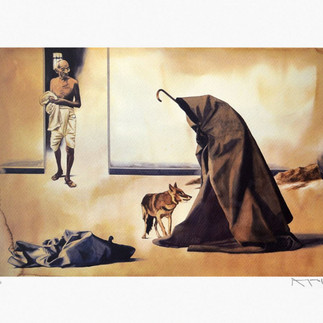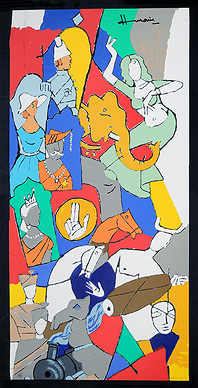77 artworks on 77 Years of Independent India
- Radhika Maheshwari

- Aug 15, 2023
- 4 min read
Art has always been a powerful medium for expressing historical narratives, cultural shifts, and the complex dynamics between nations. One particularly fascinating theme in the realm of art is the portrayal of Independent India juxtaposed against the backdrop of the British Raj. The canvas of Indian art has vividly captured the struggles, achievements, and transformations that marked this tumultuous transition from colonial rule to sovereignty. This article delves into the multifaceted ways in which artists have depicted the journey of India from the British Raj to an independent nation through 76 different artworks for the 76 years of Independent India.
We start with the most famous portrayal of India -
Bharat Mata by Abanindranath Tagore

2. Circle of Ghulam Ali Khan. Eight Men in Indian and Burmese Costume

3. Delhi Darbar by Roderick Mackenzie

4. English child seated on a pony and surrounded by three Indian servants by Shaikh Muhammad Amir

5. A Cheetah and Stag with Two Indian Attendants by George Stubbs, 1765, Oil-paint-on-canvas

6. Portrait of a Prince, Copyright Pundoles
Robert Home, Lord Cornwallis receiving the sons of Tipu Sultan as hostages after the Third Anglo-Mysore War, 1793. Cornwallis had asked for Tipu’s sons as hostages as a guarantee that Tipu would fulfil the terms of reparations that had been agreed between him and the British.

7. Political Cartoon from a Golden Age of British Satire

8. Shivaji by Raja Ravi Varma 1890

9. View of a Mosque and Gateway at Motijhil, by Sita Ram (active 1814–23) ca. 1814–23. India, Bengal.

10. Troops of the Native Allies from The Campaign in India 1857-58, a series of 26 coloured lithographs published in 1857-1858.

11. Jailer Receiving the Mahant of Tarakeshwar in Prison, Kalighat Painting, Unknown artist

The British Raj, a period of colonial rule that spanned almost two centuries, left an indelible mark on India's history and psyche. During this era, Indian artists, whether court painters, miniaturists, or landscape artists, were influenced by European techniques and aesthetics, leading to a fusion of traditional Indian art forms with Western techniques. Portraiture, often commissioned by British officials and Indian elites, became a significant genre, reflecting the power dynamics between the colonizers and the colonized.
Artists of the British Raj era often depicted a romanticized view of India, showcasing its landscapes, architecture, and cultural diversity. These depictions, while at times overly idealistic, revealed a complex relationship between the British rulers and the land they occupied. The art from this period inadvertently served as a visual commentary on the inequalities and tensions inherent in colonial rule.
12. Posters/Lithographs famously circulated to promote the idea of Patriotism - 1, Artist Unknown

13. Posters/Lithographs famously circulated to promote the idea of Patriotism - 2, Artist Unknown

14. Posters/Lithographs famously circulated to promote the idea of Patriotism - 3, Artist Unknown

15. Posters/Lithographs famously circulated to promote the idea of Patriotism - 4, Artist Unknown

16. Posters/Lithographs famously circulated to promote the idea of Patriotism - 5, Artist Unknown

17. Tiller of the Soil, Kalighat Painting, Nandlal Bose

18. The old new art of making a nation-state - Haripura Poster/Kalighat Painting, Artist Unknown

19. Galaxy of Musicians by Raja Ravi Varma

20. Mother India by Amrita Shergil

21. Refugees on Train 16 Hours Late by Krishen Khanna

22. Servant of the Raj painter of the soil by M.V. Dhurandhar

23. Pieta, 1996 by Anjalie Ela Menon

24. Bapuji by Nandlal Bose

25. East Offering Riches to the Britannia: Allegorical, oval-shaped ceiling piece commissioned by the East India Company for the Revenue Committee room in East India House.

26. A finely painted miniature depicting four British officers with their wives taking refreshments at a table, artist unknown

As India's struggle for independence gained momentum in the early 20th century, art emerged as a potent tool for dissent and nationalism. Artists began to use their creative expression to depict the hardships faced by ordinary citizens, the sacrifices of freedom fighters, and the prevailing socio-political atmosphere. The iconic "Quit India" movement, launched in 1942, inspired artists to create powerful visuals that depicted the demand for British withdrawal from India.
Political posters, woodcuts, and cartoons became mediums of choice for artists like Nandalal Bose, Bhagwan Das, and Amrita Sher-Gil to convey their message of resistance and unity. These works not only provided a rallying point for the masses but also documented the spirit of the era, encapsulating the energy and determination of the freedom struggle.
27. Wail by Satish Gujral

28. Untitled by Tyeb Mehta on Hindu and Muslim Divide

29. Untitled by Satish Gujral

30. Tagore and Gandhi by Jamini Roy

31. The artwork Jallianwala Repression and Retribution by British artists Rabindra Singh and Amrit Singh has been unveiled at Manchester Museum

32. Satyagraha by Paresh Maity

33. Refugees-1946 by Paritosh Sen

34. Paintings on Partition by PRAN NATH MAGO

35. Interior of the Hammam at the Red Fort, Delhi, Furnished According to English Taste; Artist Unknown

36. Famine series by Zainul Abedin 1943

37. Flag of Independence by Jimmy Engineer

38. Untitled Mosque by F N Souza

39. Gandhiji as Octopus with non-violence as Gunpowder by Samit Das

40. Sacrifice for Humanity by Dhiren Gandhi

41. Carrying Home 2001 by Nilima Sheikh

42. Bloodbath on Baisakhi, Artist Unknown

43. Bharatmata by Subrata Ghosh

44. Mataji 1983 by Anjolie Ela Menon (On Partition)

45. On Sikh Riots,1984 by Arpana Caur

46-48. Bapu Series by Atul Dodiya
49. Still from the animation series Lost Migrations

50. Respect by Mahesh Pal Gobra

51. Love and War by Arpana Caur

52. Leaping Bridges by Arpita Singh

53. Labour Leader by Vikrant Bhise

54. The Rise of Protests, 2021 by Vikrant Bhise

55. Zofanny, Johann Sir Elijah and Lady Impey c.1783-1784 Thyssen-Bornemisza National MuseumZofanny, Johann Sir Elijah and Lady Impey c.1783-1784 Thyssen-Bornemisza National Museum

56. Wet Platform Gandhi by Bijay Biswaal

57. Tiranga Express by Bijay Biswaal

58. Exodus by Krishen Khanna

59. Bengali Babu by Lalu Prasad Shaw

60. Cheering for India by Bharti Dayal

61. Light leaks winds meet where the waters spill, deceit by Reena Saini Kallat

62. - 74. British Raj Series by MF Hussain
Today, contemporary artists continue to explore the theme of Independent India and the British Raj, offering fresh perspectives that highlight the complexities and nuances of this historical chapter. Artworks often delve into forgotten narratives, unearthing untold stories of resistance, collaboration, and resilience during the colonial era. Additionally, artists use their creations to reflect on the enduring impact of the British Raj on India's socio-cultural fabric and identity.
75. Indira Gandhi Against Himalayas Raghu Rai

76. Statue of Unity by Ram V. Sutar

77. Unity in Diversity by Samba Prasad Biswas




























Comments